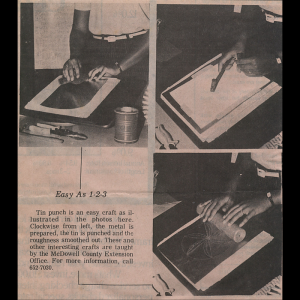Primary Source Set
Folk Arts and Crafts
While there is some debate over the terms, folk arts are art items or performances created by untrained, non-academic artisans using traditional or cultural methods of art production. These do not usually have a functional use beyond being an art piece. Folk crafts are similar, though these crafts do serve some functional purpose beyond their aesthetic use. This source set examines a variety of examples of folk arts and folk crafts from North Carolina and the many people who have lived here.
Time Period
1931-1995
Grade Level
Undergraduate
Transcript
Arts and Crafts in McDowell County Scrapbook 1
Tin production increased during colonization throughout colonies in what is now called the Americas. English colonizers brought the art of tinsmithing to the now United States and the art of tin punching spread with the craft. In other areas, tin production made the metal significantly cheaper and became incorporated into previous folk art and craft traditions, like in Mexico. Tin punching is done by using thin sheets of tin and punching patterns into the sheet to make art or craft pieces like lantern covers. Artists in McDowell County taught this folk art, an important aspect of the revival of many folk arts and crafts.
Contributed to DigitalNC by McDowell County Public Library
McDowell County, NC (McDowell County)
Background
When learning about the history and traditions of folk arts and crafts, we must define the terms ‘folk art’ and ‘folk craft’.
Folk art is a term used to describe art that is created by untrained artists that use traditional and/or cultural methods for creating art instead of following an academic or professional methodology. These folk arts usually do not have any functional purpose beyond being a piece of art.
Folk crafts are also made by untrained, non-academic people who use traditional and/or cultural means of producing items, though folk crafts do have a functional purpose beyond their artisanal aesthetic. The two are extremely similar in terms of who makes them and the culturally grounded creation process, but it is the functionality that distinguishes them in formal definitions.
Folk arts and crafts have existed for as long as people have been creating, and these traditions continue through to today. Artists and craftspeople create paintings, pottery, wood carvings, sculptures, and even tombstones They reflect the folklife (or the ways of living) of a given community, and showcase both similarities and differences between communities. These communities are often defined geographically, but also have roots in religious, racial, ethnic, and/or cultural identities. Some communities overlap and meld in identity and tradition, from Appalachian to African-American/Black folk arts and crafts.
Folklife and traditions like folk arts and crafts help people to form and define their identities and better understand how they relate to others. By examining folk arts and crafts, this source set aims to show the variety of folklife and traditions found in the state and asks us to examine our own relationship to folklife and each other.
Discussion Questions
Assumptions About Folklife
- Before starting with this primary source set, what were your assumptions or knowledge of folklife and folk arts and crafts?**
- What did these folk arts and crafts reveal about life in North Carolina for the communities featured in the primary sources?**
- What evidence did these primary sources provide to either reinforce or challenge your previous understanding of folklife, arts, and crafts?**
- How might this impact the way you engage with folklife and practices in the future?**
Folk Traditions across Communities
- When considering folk music, what connections are evident between the folk musicians Clark Jones, Yusuf Salim, Odell Thompson, and Joe Thompson?*
- What other examples from the primary source sets can relate to these folk music traditions?*
- What might be different about their experience with and traditions of folk music?**
- Examples of pottery traditions were shown from unnamed indigenous people held in Edgecombe County, the Cole family in Lee County, and Aunt Sophie Campbell in Haywood County.
- What points of connection can be made between the different traditions?*
- How do these traditions differ?*
- How might the different communities these people belonged to impact how their pottery is treated and viewed today?**
- What North Carolina communities represented in the primary sources were you already familiar with in regards to their folk art and craft traditions?*
- What communities’ traditions had you not encountered before?*
- What may have contributed to your previous familiarity or lack thereof?**
- What communities’ traditions had you not encountered before?*
- In what ways have folk arts and crafts changed over time?**
- What are the factors that contributed to these changes?**
- When considering folk music, what connections are evident between the folk musicians Clark Jones, Yusuf Salim, Odell Thompson, and Joe Thompson?*
Folk Art and Craft Influence
- What influences were noticeable in the primary sources?*
- What influences on North Carolina folk art and craft traditions can be found through further research or reviewing the context for each primary source?**
- What does this reveal about folk life in general?**
- What does this reveal about the impact of globalization and colonization on folklife and folk traditions?**
- What influences were present that you would not have expected?**
- What influences were absent that you may have expected to be present?**
- What influences were noticeable in the primary sources?*
For Teachers
- "Selling Tradition" Chapter 5 'I Start as Early as I Can and Work as Hard as I Can: Mountain Craft Producers and Their Work' by Jane S. Becker
- "Selling Tradition" Chapter 6 - 'Labor or Leisure?: Industrial Homework and the Redefinition of Craftsmanship' by Jane S. Becker
- "Selling Tradition" Chapter 7 'Selling Tradition' by Jane S. Becker
Updated January 2025
